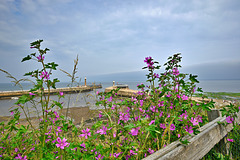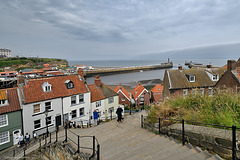
HFF
The boss built a new fence..... (HFF everyone)
Whitby, East Pier Lighthouse (HFF everyone)
| |
|
|
|
Whitby East Pier Light (or Whitby East Breakwater Light), was built in 1854. The stone built lighthouse stands 55 foot high ( approx 16 mtrs) and had a light visible from 8 miles (approx 13 km).
This was replaced in 1914, by the new Whitby east pier light. The new light was built as a wooden framework tower on 'legs', at the seaward end of the new pier extension. Currently operational, it displays an automated fixed red light (red for port).
The view is to the east and Saltwick Nab promontory (see below)
Harbour flowers (HFF everyone)
Harbour mouth and piers from the Abbey Steps (HFF…
| |
|
|
|
The two piers in Whitby have been in existence since before the 1500's. By 1540, the two oak piers (east and west) were replaced partially, with stonework (in the reign of King Charles 1), with further work around the 1600's. Both piers were rebuilt in 1735, each measuring approximately 183m, but by 1814 the west pier was further extended to reach a length of 309m. In 1905, both the piers had new pier ends built on, each of a length of 152m.
The west pier lighthouse was built in 1831, and is a stone 83 feet column tower with a lantern on top. This light still displays a green light when shipping is expected. This lighthouse was replaced in 1914, by a wooden framework tower on 'legs, located at the seaward end of the new pier extension.
Whitby East Pier Light (or Whitby East Breakwater Light), was built in 1854. The stone built lighthouse stands 55 foot high ( approx 16 mtrs) and had a light visible from 8 miles (approx 13 km).
This too was replaced in 1914, by the new Whitby east pier light. The new light was built as a wooden framework tower on 'legs', again at the seaward end of the new pier extension. Currently operational, it displays an automated fixed red light (red for port).
Coble - Sea Salt (HFF Everyone)
| |
|
|
|
The blue and white boat on the sand is a recently rescued and refurbished traditional local Fishing Coble that was built in 1963. ‘Sea Salt' regularly leaves Whitby Harbour to harvest the sea salt which in turn will help to preserve this valuable, traditional wooden fishing boat for generations to come.
The coble is a type of open traditional fishing boat which developed on the North East coast of England. The southernmost examples occur around Hull, the type extends to Burnmouth just across the Scottish border.
The distinctive shape of the boat — flat-bottomed and high-bowed — arose to cope with the particular conditions prevalent in this area. Flat bottoms allowed launching from and landing upon shallow, sandy beaches; an advantage in this part of the coast where the wide bays and inlets provided little shelter from stormy weather. However, fishermen required high bows to sail in the dangerous North Sea and in particular to launch into the surf and to land on the beaches. The design contains relics of Norse influence, though in the main it shows Dutch origin.
Local boat-builders constructed the clinker-built cobles locally as required, without the use of plans. The craftsmanship on many boats gave them a long working life. They had a reputation as dangerous to sail for an inexperienced crew, but in the hands of experts could move both safely and speedily.
Today, surviving cobles generally use diesel engines, removing the need for the distinctively shaped lug sail.
Calm before the storm (HFF Everyone)
| |
|
|
|
HFF 09/04/2021
The larger boats in the picture are two of several operated by the Keswick Launch Company. They start their journey here at the Keswick boat landings and cruise around the lake stopping at seven lakeshore jetties where you may go ashore or join the various boats. Alternatively, you can stay on the boat and enjoy the 50 minute trip around Derwentwater.
Derwentwater (or Derwent Water) is one of the principal bodies of water in the Lake District National Park in north west England. It lies wholly within the Borough of Allerdale, in the county of Cumbria.
The lake occupies part of Borrowdale and lies immediately south of the town of Keswick. It is both fed and drained by the River Derwent. It measures approximately is 4.8 km long by 1.6 km wide and is some 22 m deep. There are several islands within the lake, one of which is inhabited.
Not to be trusted (HFF Everyone)
| |
|
|
|
HFF 2/4/2021
Cliff height at this point - 510 ft/155 mtrs
The view is from Ravenscar to the north over Robin Hood's Bay, with the village of Bay Town (local name) just visible beyond the 'fence'. The flat area of rock, below right, is the home of a colony of seals.
Ennerdale Water (HFF Everyone)
| |
|
|
|
HFF 26/3/2021
Ennerdale Water with craggy Bowness Knott and surrounding fells.
Ennerdale Water, fed by the River Liza, is the most westerly lake in the Lake District National Park in Cumbria, England. It is a glacial lake, with a maximum depth of 150 feet (45 metres), and is ½ mile to a mile (700 to 1,500 metres) wide and 2½ miles (3.9 kilometres) long.
The lake lies in the valley of Ennerdale, surrounded by some of the highest and best-known fells in Cumbria including: Great Gable (899 m), Green Gable, Brandreth, High Crag, Steeple and Pillar. To the west of the lake lies the hamlet of Ennerdale Bridge, consisting of two pubs and a few houses.
Winter HFF Everyone
Cumbrian Sunset (HFF Everyone)
Black and Blue - HFF Everyone
| |
|
|
|
Copper Beech and Copper Lamps (HFF Everyone!)
| |
|
|
|
By Beverly Minster - East Yorkshire
Beverley Minster in Beverley, East Riding of Yorkshire, is a parish church in the Church of England. It is one of the largest parish churches in the UK, larger than one-third of all English cathedrals and regarded as a Gothic masterpiece by many.
HFF Everyone! (1 xPiP)
| |
|
|
|
HFF 6/11/20
All Weather Shannon Class Lifeboat named Frederick William Plaxton
Funded by: Mr F W Plaxton, The F W Plaxton Charitable Trust, The Ganton Furse Settlement and Mr Willaim Ranyard.
The Shannon-class lifeboat is the latest class of lifeboat currently being deployed to the RNLI fleet to serve the shores of the British Isles. The class is named after the River Shannon, the longest river in Ireland. This is the first time that the name of an Irish river has been used for a class of RNLI lifeboat.
The RNLI
The Royal National Lifeboat Institution is the largest charity that saves lives at sea around the coasts of the United Kingdom, the Republic of Ireland, the Channel Islands, and the Isle of Man, as well as on some inland waterways.
Scarborough Foreshore Lights (HFF Everyone)
Misty Evening (HFF Everyone)
| |
|
|
|
Boats landing their catch at the fish market - Scarborough Harbour
HFF Everyone
Thank you all so much for your visits and kind comments, they are much appreciated
Border Rainbow (HFF Everyone)
HFF Everyone
Not been able to do a thing with my hair since loc…
| |
|
|
|
Jump to top
RSS feed- Latest items - Subscribe to the latest items added to this album
- ipernity © 2007-2024
- Help & Contact
|
Club news
|
About ipernity
|
History |
ipernity Club & Prices |
Guide of good conduct
Donate | Group guidelines | Privacy policy | Terms of use | Statutes | In memoria -
Facebook
Twitter


















